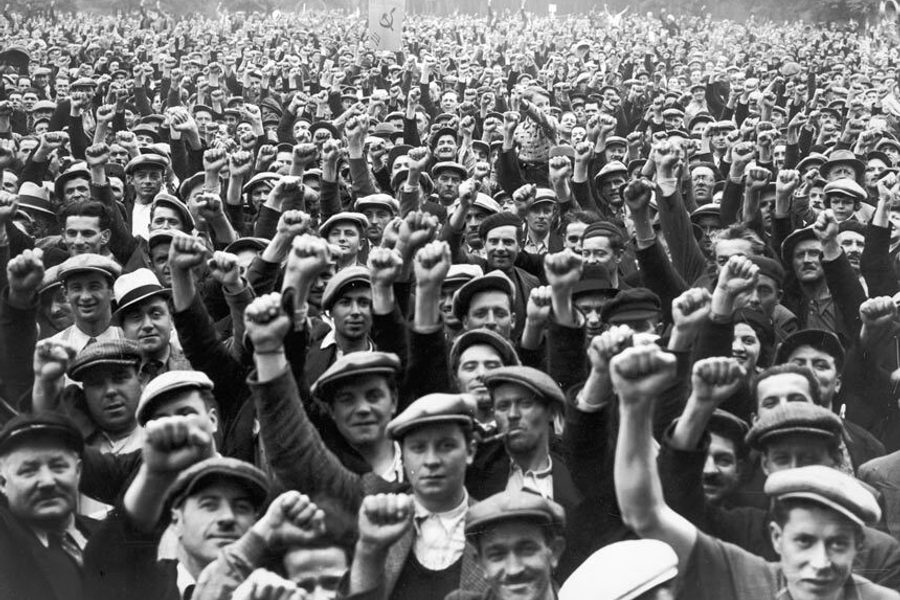Why Are Socialists Always Talking About the Working Class?
A discussion about class in the 21st century.
In These Times Contributors

Only the workers can smash the machine
Bhaskar Sunkara
At the end of the Democratic Socialists of America convention this summer, the participants gathered to sing that venerable leftist anthem, “The Internationale.” The delegates and observers, most of whom likely weren’t a day older than 30, sang one line with special conviction: “The international working class shall be the human race.”
To some it must have seemed ridiculous. But old habits die hard.
For the last century and a half, the working class has been at the center of socialist politics. Marxists, in particular, didn’t romanticize workers because they were oppressed, ripped from their land and suffering in crowded factories and squalid slums. They paid attention to the working class because workers were more powerful than they knew.
Capitalism saw the world increasingly divided between those who controlled and coordinated production and those who had to offer up their labor. The capitalists grew wealthy; workers remained poor. But it wasn’t just that. Workers’ lives were insecure, they had to give up their autonomy to keep their jobs — there was no alternative to surrendering themselves to domination and exploitation at the hands of others. They worked or they starved.
But workers of any race, gender and era, including our own, have something in common: an antagonism toward the people who pose to them such an unfair bargain. This collective injustice gives workers a common interest in resistance. More importantly, their key role in producing society’s wealth means that their disruptions can shake the system to its core. Individual workers, of course, can’t do it alone. They need to bridge divides and organize with others to win concessions. Many have found it safer to avoid such actions and keep their heads down. That seems perfectly rational — we may be many, but they are powerful.
Yet, at certain moments, through the creation of trade unions and political organizations to represent the specific class interests of workers, collective action has become a real option. Workers have taken this option to accomplish incredible things. Across the world, worker parties took power to either try to manage the capitalist state the best they could, in their interests, or to try to overcome it entirely. The results were mixed, but the fact that we live in societies with doses of humanity and justice is a credit to their efforts.
Of course, times have changed since Marx published Capital 150 years ago — or even since powerful parties of the Left ruled from Kingston, Jamaica, to Stockholm, Sweden, in the 1960s and 1970s. There was once a time when you could go to a working-class neighborhood in a place like Bologna, Italy, and immediately know it. A few industries might have been the key source of employment for the area. People lived densely packed together, forced by capitalism into, if not bonds of solidarity, then at least commonality. True to this shared condition, they voted in the main for parties of the broad Left. The job of the revolutionary was to convince workers committed to a politics of reform to embrace a politics of rupture.
Today, you might find pockets of this across the advanced capitalist world, but it is the exception, not the rule. The working class is fragmented. William Morris wrote in 1885 that while workers are a class, socialists must convince them “they ought to be Society.” Now we have to convince them about that class part, too.
Though the working class has indeed changed, the shifts are overstated by those, such as University of London professor Guy Standing, who proclaim this to be the era of the “precariat.” There’s nothing new about workers suffering through precarious, low-wage employment. Whatever semblance of security was possible in decades past was not due to the inherent nature of “pre-neoliberal” capitalism, but the result of successful class struggle and organization.
True, the percentage of workers employed in industrial manufacturing has declined in recent decades — but that’s been the case since the late 19th century. The workers still left in those sectors (in raw numbers, more than ever) aren’t necessarily less powerful as a result — but it does mean that for the sake of building a majoritarian electoral coalition, socialists need to think more broadly.
Luckily, our conception of a working class goes beyond formally employed workers, to the labor and political agency found in households and communities. But the traditional workplace should still be central to our vision. In the 21st century, that means putting special emphasis on workers in growing sectors, like teachers and healthcare professionals, as well as those working in supply and logistics. It also means developing connections between the unemployed and the employed and pursuing a broad practice of social justice unionism (union organizing that goes beyond typical labor demands) capable of marshaling support for strikes and policy initiatives that spring up from the labor movement.
Figuring out how to put this vision into practice will require constantly innovating our tactics and political strategy, as well as struggles focused around combating racism, sexism and nativism.
Working people are as different and divided as ever, yet they are still positioned to rattle the system and win real gains. We simply cannot have an emancipatory politics within capitalism that doesn’t revolve around the class whose labor makes the system run.
There are more systems to smash
Kathi Weeks
I agree with Bhaskar about both the theoretical importance of class analysis and the practical successes of class struggle historically. But I also think his valuable insights about the heterogeneity of workers, alongside his call for a more expansive conception of socialist politics, should be developed further. We must embrace multiple lines of social analysis beyond class and capitalism, and move toward a fully coalitional model of emancipatory politics.
“For the last century and a half,” Bhaskar writes, “the working class has been at the center of socialist politics.” This may be true. But this telling of left history risks eclipsing the roles played by the tale’s other protagonists. To his credit, Bhaskar recognizes that “working people are as different and divided as ever,” and acknowledges that socialist politics today must include “struggles focused around combating racism, sexism and nativism.” Yet in the end, class unity seems to prevail: “Workers of any race, gender and era, including our own, have something in common: an antagonism toward the people who pose to them such an unfair bargain.” While I appreciate this account of how common ground can be found within difference, this formulation threatens to pose gender and race antagonism as subordinate to class antagonism.
Members of the working class do not have only class interests, and capitalism is not the only mode of domination we need to study and contest. We are never only workers, but workers whose lives are shaped by our gender, race, sexuality, citizenship and disability. Furthermore, it is not only racism, sexism and nativism that we must attend to but the systems of white supremacy, patriarchy and national sovereignty of which they serve as ideological supports. Just as capitalist exploitation cannot be reduced to the problem of mere class bias, the problems that feminists, anti-racists and others take on have deep structural roots. Certainly these other systems intersect and interact with capitalism, but they cannot be subsumed under capitalism as if they were somehow secondary to or mere offshoots of it.
Let me offer two brief examples that show the need for a more expansive set of analytical tools and political strategies. First, violence against women: To grasp the causes and find solutions, we should also interrogate the historical connections between the gender divisions of labor under capitalism — for example, how women are confined to lower-waged jobs and tied more closely to family responsibilities — and gendered relations of power in society more broadly that might manifest in violence. Second, police violence against people of color: To confront this crisis, we must map out the historical entanglements of a capitalist political economy with slavery, the prison-industrial complex and other forms of institutional racism, including racist policing. Neither problem, violence against women nor police violence against communities of color, can be addressed by class analysis alone or solely through working-class activism.
Rather than cling to class as a master category, class unity as an ideal and the working class as the agent of emancipation, I want to argue for recognizing the relative autonomy of myriad political struggles — among others, those organized around the categories of class, race, gender, sexuality and disability. Building on the same logic, we can also appreciate the potential for coalitional solidarity and cooperation among them.
A comparison might bring my claim into sharper focus. U.S. feminist theory and politics over the last 50 years has struggled mightily with the fact that “women” (like “working class”) is not a unitary category, and has been forced to respond to various instances where white, middle-class, heterosexual and cis women have mistakenly imagined themselves as representative of “women.” To the extent that feminists have made good on this insight — definitely a work in progress — we have built a more inclusive movement that fully acknowledges our differences, and feminist politics has been made stronger.
In order to achieve the laudable goal Bhaskar lays out, “to rattle the system and win real gains,” I would argue in favor of trading unity for coalition. By expanding our theories and practices, I think emancipatory politics — including socialist politics specifically and anti-capitalist politics more broadly — would not be diminished but made more powerful and durable.
We can build a better system
Kali Akuno
For the first time, virtually all of humanity is incorporated into one social order and one mode of production: the capitalist world-system. More people are involved in commodity production and exchange — as wage-laborers, indentured servants, prisoners or slaves — than ever. This means that the working class is larger and potentially more powerful than at any other point in history.
So I agree with Bhaskar that the working class is in a central position to transform the world-system. He is also right that the working class is fragmented, for all the reasons that Kathi mentions (and then some).
Social perceptions and consciousness can change rapidly, given the right conditions, as the past seven years of global events demonstrate. The instability we are now experiencing — wars, ethnocentric and religious violence, terrorism, mass migration, and the rise of right-wing nationalism and outright fascism — is accelerating the transformation of consciousness and political action the world over. On the progressive side, we have seen millions of working-class people challenge and even topple dictatorships in Africa and Asia, and millions mobilize to confront growing inequality and dispossession in the democracies of Europe and North America. This shows that even without mass left organizations, the working class can act as a political force.
But for the most part, the Left has been eviscerated through political repression, capitulation to neoliberalism and the trappings of electoral politics that serve to legitimize rather than challenge the system. In places like Egypt, Libya and Syria, this evisceration led to the reorganization of dictatorships. It also means that the gains in Europe and the United States have been limited to shifts in the public discourse about class and inequality, and relatively minor progressive policy shifts. More is clearly needed.
Unfortunately, in much of the world (including the United States), the Right is doing better than the Left at reaching working people who feel they are losing their status, privileges and birthrights. For the working class to play a transformative role in society, we must build our own left-oriented organizations and institutions, and quickly.
These organizations and institutions must not aim to recreate the social-democratic or electoral routes to power of the past century. Instead, the Left must build a new type of revolutionary working-class organization. This type of organization must learn from and transcend the 20th century’s failures of both the vanguard — with its emphasis on centralism over democracy — and social-democratic parties — with their faith in representative democracy and the neutrality of capital.
We must be prepared to both build and fight: fight the impositions of capital where we work, live, play and pray, and build, from the ground up, institutions on the basis of social solidarity and ecological regeneration, such as worker cooperatives and time banks.
Kathi’s emphasis on coalitional politics may go too far in decentering capitalism, but she is right that a new working-class movement must take on multiple modes of domination, oppression and hierarchy. In my view, capitalism is the nexus of oppression in our era, and fashions and conditions all other forms of oppression in its own service — colonialism, ethnocentrism, racism, white supremacy, patriarchy, heterosexism, ageism, ableism, et al. Of course, other systems of oppression have their own logic and animus, and some, like patriarchy and heterosexism, are much older and socially entrenched than capitalism.
This new type of organization must recognize that working-class people aren’t just one-dimensional beings: They have concerns, needs, wants and desires that go beyond wages and work conditions. It must also recognize that class position is conditioned by race, ethnicity, nationality, language, religion, sexuality, gender, age and physical ability — these concerns are not just “add-ons” to the class struggle.
On this basis, our movement can advance a vision of a wholly new system, a new communist civilization, rather than settling for an exploitative system with the wherewithal to accommodate more Black presidents, Queer soldiers and Woman preachers. We can and must do better. The suffering mass of humanity, and all the life forms capitalism is rapidly extinguishing, demand nothing less.








